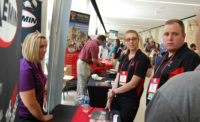Higher Education
A behind-the-scenes look at the AMSA 2019 RMC Iron Chef Competition

To kick off the American Meat Science Association’s (AMSA) 72nd Reciprocal Meat Conference (RMC), students were given the opportunity to spice up their cooking skills in Greeley, Colo. On June 22, 2019, 124 students from 13 universities participated in the Iron Chef Competition sponsored by JBS USA Food Company and their affiliate Pilgrim’s.
The morning began when the students were broken into ten groups, giving them the opportunity to work alongside and network with students from different universities. Once in groups they were given their product, a whole chicken, and told to brainstorm two different dishes they wished to prepare from them. The groups then headed up to the JBS USA Food Company headquarters in Greeley to work alongside industry chefs in the JBS kitchen. Once in the kitchen, each group was given, at random, two different spices to use in their dishes. Spices ranged from coffee ground spices to Cuban-inspired spices.
The first part of the competition began as soon as the students arrived at the headquarters and began deconstructing a whole chicken. Each team was given three whole chickens and a time limit of about two hours to prepare their cuts, take a photo of their finished product and separate out the breasts, legs and wings. The fun part was watching the students who knew what they were doing teach the others in their group and explain why they make a certain cut or where to cut. Whereas other groups were watching YouTube videos to quickly learn how to deconstruct their chicken properly and efficiently.
While the students were deconstructing their chickens, professional chefs and mentors from Pilgrim’s, Newly Weds Foods and JBT were preparing their own chicken dishes. These dishes were used for the chef’s plating demonstration during the student’s lunch break. Each chef went through an entire plating explanation from start to finish, showing the students how to add a sauce with a brush stroke, place sides in a decorative manner, and how to cut and display their final chicken products best. The chefs used their finished dishes as inspiration to encourage the students to take what they learned from the plating demonstration and use those tips and ideas to create beautiful plates of their own.
After this demonstration the students headed back into the kitchen to begin their preparation and cooking processes with their respective chicken cuts or whole chickens. Many teams experimented with their spices by injecting or seasoning; some added the spice to their breading mix, and one group made a sauce to be applied later. The kitchen became hectic with wings, nuggets, and whole chickens being prepared, because there were quite simply too many cooks in the kitchen.
After about an hour of seasoning and injecting the cooking process began. Whole chickens went into the rotisserie, nuggets were breaded and thrown in the fryer, breasts were baked, and one team even prepared sausage to fry into corndogs. By this point the contestants really started to get excited about their creations and what else could be done to their finished plates. Some teams began creating sauces while others were envisioning how their plates would look. The professional chefs also circulated the kitchen at this time encouraging the students and giving teams helpful tips and tricks.
After a full day of cutting, preparing, cooking, and planning the teams plated their creations and headed into the judging room. One by one the teams went into the room to be judged on their picture of the deconstructed whole chickens, as well as how well their dish was plated, tasted and the overall preparation of the chicken.
The real fun began after the judging. The students set up their dishes in the cafeteria, and RMC attendees came through the cafeteria to try their creations. The tasters went around to the groups and were given the chance to ask questions and try all the different creations. Votes were then collected from the attendees to see what dish was the favorite and would be awarded The People’s Choice Award. Although the race was a pretty close one, the creativity and taste of the chicken corndog came out on top.
As the voting wrapped up and the students began cleaning up and saying goodbye to their new friends and teammates, the true meaning of the Iron Chef Competition was apparent. Watching the interactions showed how much the students had gained from the experience.
Oklahoma State University graduate student Laura Yoder summed up the experience perfectly saying, “Working with Pilgrim’s, Newly Weds Foods and JBT allowed us as students to get to know some of our team members, as well as work in a facility with companies that collaborate daily. Getting to know other students from across the country helped me build my network, work in a team, and create products with unique flavors, raw materials and application processes that most learn about but don’t always get to apply firsthand. Getting hands-on experience with such large companies that have a big impact on our industry was a fun way to get to see what they may experience on a day-to-day basis as scientists in R&D, as well as help give students some insight into what it can be like to make a product with new and innovative flavors, raw materials and techniques!”
Although they did learn about preparing and plating chicken dishes, more importantly, they made new connections and friendships. By having universities split up, the students were forced to make connections with new people, many of which will last a lifetime. The competition also gave the students the opportunity to network with industry people and industry chefs and try things most only dream of.
Looking for a reprint of this article?
From high-res PDFs to custom plaques, order your copy today!




